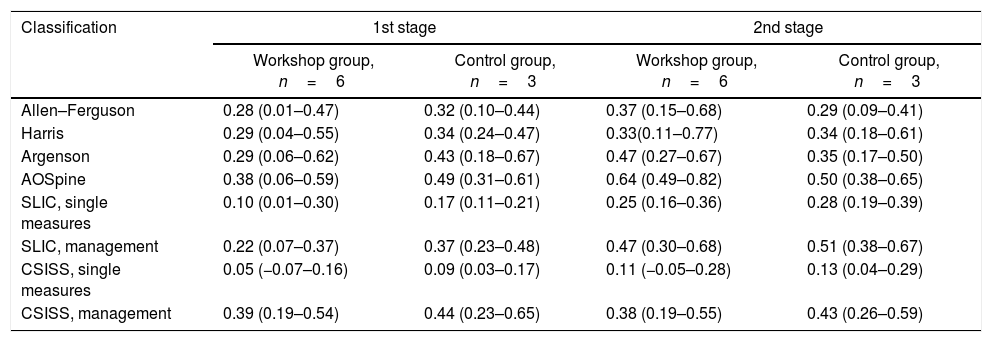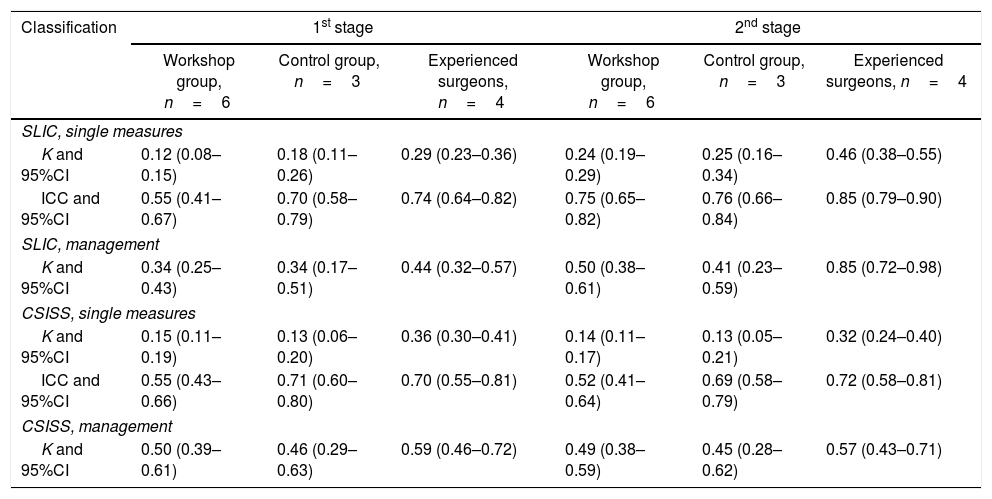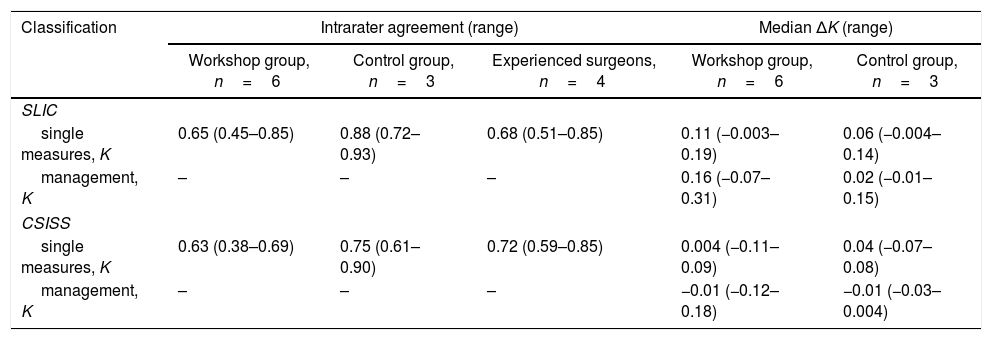To compare the teachability of the Allen–Ferguson, Harris, Argenson, AOSpine, Subaxial Cervical Spine Injury Classification (SLIC), Subaxial Cervical Spine Injury Classification (CSISS) and to identify the classification that a group of residents and junior neurosurgeons find easiest to learn.
MethodsWe used data from 64 consecutive patients. Answers of nine residents and junior neurosurgeons and four experienced surgeons in two assessment procedures were used. Six raters (workshop group) participated in special seminars between assessments. Three other raters formed the control group. Experienced surgeon's answers were used for comparison. Teachability was measured as the median value of the difference (ΔK) in the interrater agreement on the same patients by the same pairs of subjects.
ResultsMedian Δ K for the Allen–Ferguson, Harris, Argenson and AOSpine classifications were: (1) 0.01, 0.02, 0.29, and 0.39 for the workshop group; (2). 0.09, −0.03, 0.06 and 0.04 for the control group, respectively. Between numerical scales, median ΔK was higher for SLIC but did not exceed 0.16. Interrater consistency with expert's opinion was increased in the workshop group for Allen–Ferguson, Argenson and AOSpine and did not differ in either group for SLIC and CSISS.
ConclusionThe AOSpine classification was the most teachable. Among numeric scales, SLIC demonstrated better results. The successful application of these classifications by residents and junior neurosurgeons was possible after a short educational course. The use of these scales in educational cycles at the stage of residency can significantly simplify the communication between specialists, especially at the stage of patient admission.
Comparar la educabilidad de las clasificaciones de Allen-Ferguson, Harris, Argenson, AOSpine, Subaxial Cervical Spine Injury Classification (SLIC), Subaxial Cervical Spine Injury Classification (CSISS) e identificar la clasificación que un grupo de residentes y neurocirujanos jóvenes encuentran más fácil para aprender.
MétodosUsamos los datos de 64 pacientes consecutivos. Se utilizaron las respuestas de 9 residentes y neurocirujanos jóvenes y 4 cirujanos experimentados en 2 procedimientos de evaluación. Seis evaluadores (grupo de talleres) participaron en seminarios especiales entre evaluaciones. Otros 3 evaluadores formaron el grupo de control. Se utilizaron las respuestas de cirujanos experimentados a modo de comparación. La educabilidad se midió como el valor mediano de la diferencia (ΔK) en el acuerdo entre observadores sobre los mismos pacientes por los mismos pares de evaluadores.
ResultadosLa mediana de ΔK para las clasificaciones de Allen-Ferguson, Harris, Argenson y AOSpine fue: 1) 0,01; 0,02; 0,29 y 0,39 para el grupo del taller; 2) 0,09; −0,03; 0,06 y 0,04 para el grupo de control, respectivamente. Entre las escalas numéricas, la mediana de ΔK fue mayor para SLIC pero no excedió 0,16. La coherencia entre evaluadores y los expertos aumentó en el grupo de taller para Allen-Ferguson, Argenson y AOSpine y no difirió en ninguno de los grupos para SLIC y CSISS.
ConclusiónLa clasificación AOSpine tuvo la mejor educabilidad. Entre las escalas numéricas, SLIC demostró mejores resultados. La aplicación exitosa de estas clasificaciones por residentes y neurocirujanos junior fue posible después de un breve curso educativo. El uso de estas escalas en los ciclos educativos en la etapa de residencia puede simplificar significativamente la comunicación entre especialistas, principalmente en la etapa de ingreso del paciente.
Article

If it is the first time you have accessed you can obtain your credentials by contacting Elsevier Spain in suscripciones@elsevier.com or by calling our Customer Service at902 88 87 40 if you are calling from Spain or at +34 932 418 800 (from 9 to 18h., GMT + 1) if you are calling outside of Spain.
If you already have your login data, please click here .
If you have forgotten your password you can you can recover it by clicking here and selecting the option ¿I have forgotten my password¿.












